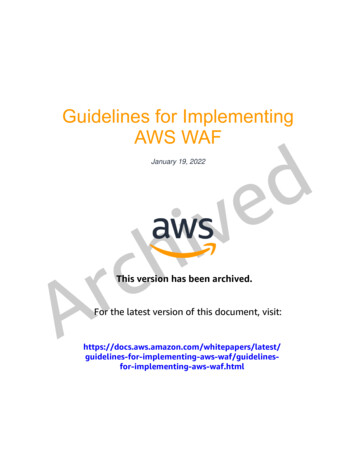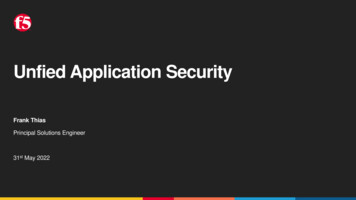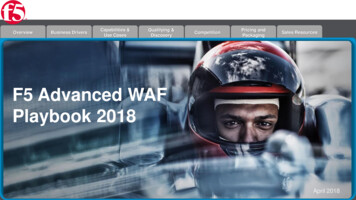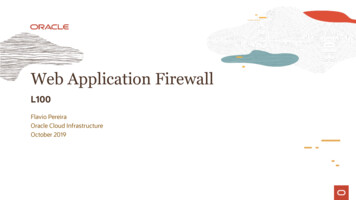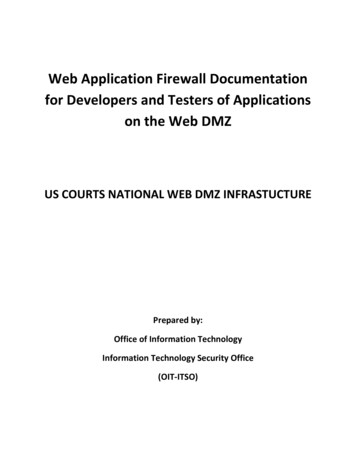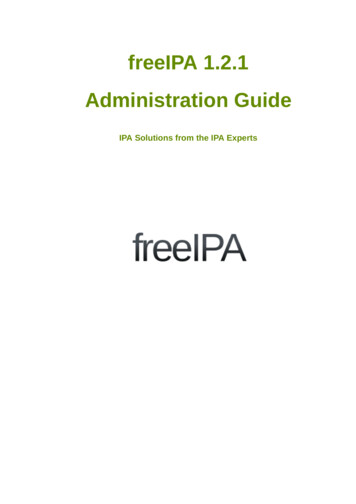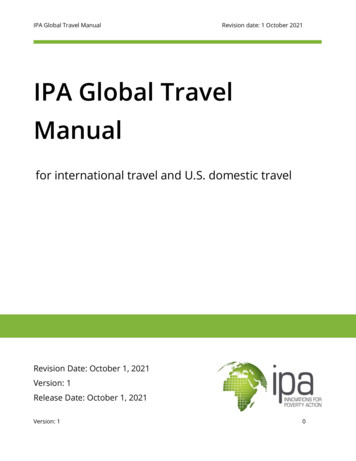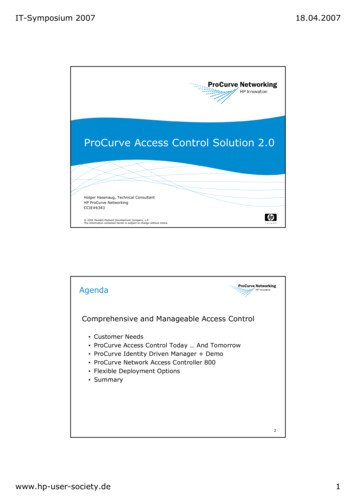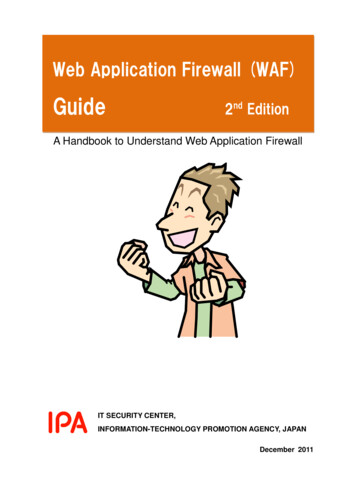
Transcription
Web Application Firewall (WAF)Guide2nd EditionWeb Application Firewall を理解するための手引きA Handbook to Understand Web Application FirewallIT SECURITY CENTER,INFORMATION-TECHNOLOGY PROMOTION AGENCY, JAPANDecember 2011
This guide is available for download at:Web Application Firewall (WAF) Guidehttp://www.ipa.go.jp/security/vuln/waf.html (Japanese web page)Translated by Hiroko Okashita (IPA), Dec 27 2011
ContentsContents. 1Preface . 2Intended Readers . 2Organization of the Guide . 2Caution on the Use of the Guide . 3What’s New in the 2nd Edition . 31.Web Application Vulnerability Countermeasures with WAF . 41.1.WAF: Mitigate the Impact of Attacks . 41.2.Current Situation of Attacks against Web Applications and VulnerabilityCountermeasures . 51.3.2.3.4.5.Approach to the Use of WAF. 7WAF Overview . 92.1.What WAF Is. 92.2.Difference between WAF and FW & WAF and IPS . 102.3.Types of WAF . 132.4.Situations Where WAF is Effective . 15WAF Specifics. 183.1.WAF Deployment. 183.2.WAF Features . 203.3.Points to Remember with WAF Features . 30WAF Introduction . 324.1.Decision of Introduction . 334.2.Introduction . 374.3.Operation . 48WAF Introduction Case Study at IPA . 515.1.Introduction . 515.2.Decision of Introduction . 535.3.Introduction . 575.4.Operation . 715.5.Summary of WAF Introduction and Operation . 75Appendix A. Open Source Software WAF. 76ModSecurity . 76WebKnight . 84Appendix B. Commercial WAF . 93Terminology . 961
PrefaceWeb Application Firewall (WAF) is one of the security measures to protect web rabilitiesinwebapplications.Information-technology Promotion Agency (IPA) has prepared this guide to help websiteoperators understand what the WAF is, what it can do and how to introduce it.IPA hopes this guide will help website operators protect their web applications with a WAF.Intended ReadersThis guide is intended for the website operators who are considering the possibility ofintroducing a WAF.In this guide, a website operator means an entity or individual that has and operates awebsite. For example, the website operator of http://www.ipa.go.jp/ is IPA.Organization of the GuideThis guide is composed of 5 chapters and 2 appendixes.Chapter 1, "Web Application Vulnerability Countermeasures with WAF," presents thecurrent situation of attacks against Web applications and vulnerability that IPA analyzedfrom its activities and the approaches by some security organizations.Chapter 2, "WAF Overview," explains about WAF. The purpose of this chapter is to help thewebsite operators understand what the WAF is.Chapter 3, "WAF Specifics," gives the details on the WAF. The purpose of this chapter is tohelp the website operators understand the features of the WAF and the points when usingthose features.Chapter 4, "WAF Introduction," shows the points to be considered through each of threephases of the WAF introduction: decision of introduction, introduction and operation.Chapter 5, “WAF Introduction Case Study at IPA” presents a case study of introducing andoperating an open source WAF “ModSecurity” at IPA, and shows what IPA actually consideredand did through each phase of “decision of introduction”, “introduction” and “operation”. Byreading Chapter 5 together with Chapter 4 “WAF Introduction”, IPA hopes that the readerswill understand the important points in introducing a WAF.Appendix A, "Open Source Software WAF," gives the introduction case study of ModSecurityand WebKnight.Appendix B, "Commercial WAF," provides the commercial WAF products of the vendors thatcontributed to this guide.2
Caution on the Use of the GuideThis guide provides the information on the general features, behaviors and issues of theWAF. Some WAF products may behave differently from what is shown in this guide.What’s New in the 2nd EditionIn the 2nd edition, Chapter 4 “WAF Introduction” has been expanded, and a case study ofintroducing an open source WAF “ModSecurity” at IPA is added as Chapter 5, “WAFIntroduction Case Study at IPA”. Reading Chapter 4 and 5 together will help the readersunderstand from introduction to operation of WAF in detail.Other contents such as those in Section 2.4 “Situations Where WAF is Effective” and theModSecurity case study in Appendix A are also revised.3
1. Web Application VulnerabilityCountermeasures with WAFThis chapter introduces the current situation of attacks against web applications andvulnerability countermeasures that IPA analyzed from its activities and the approaches bysome security organizations.1.1. WAF: Mitigate the Impact of AttacksWAF is one of the security measures to protect web applications from attacks that try toexploit the vulnerabilities in web applications. WAF is an operational security measure thatmitigates the impact of attacks, not a fundamental solution that eliminates the vulnerabilityin web application implementation.IPA offers the guidelines for the application developers to help eliminate the vulnerabilitiesin web applications, such as "How to Secure Your Web Site"1, and "Secure ProgrammingCourse"2. Still, the attacks that exploit the vulnerabilities in web applications show no sign ofend, and as seen through the Information Security Early Warning Partnership3, it is not thateasy for the website operators to quickly fix the vulnerability in their website for variousreasons. Under this circumstance, the WAF can be an effective security measure to protectweb /websecurity.html vendor/programmingv2/index.html nership guide.html (Japanese)4
1.2. Current Situation of Attacks against Web Applicationsand Vulnerability CountermeasuresThis section introduces the current situation of attacks against web applications andvulnerability countermeasures for websites that IPA analyzed from its activities.1.2.1. Attacks against JVN iPediaIPA analyzed access log of JVN iPedia 4 , a database of vulnerability countermeasureinformation operated by IPA and JPCERT Coordination Center, with a website attackdetection tool iLogScanner5. Between January 2009 and December 2010, 12,194 transactionsthat seemed to be an attack were detected (Figure 1-1).Number of Attacks That Seemed to Have Targeted JVN iPedia WebsiteWebsite Analyzed: JVN iPedia (Vulnerability Countermeasure Information Website)Analyzed Access Log : From January 2009 to December 2010Accesses That Seemed Attacks: 12,194 Attacks That Might Have Succeeded: 0Others (attacks to bypass IDS)OS Command InjectionCross-Site ScriptingDirectory TraversalSQL ,9853,2591,5001,0639746224519641,00023050006292009 1Q9127473412009 2Q2009 3Q2009 4Q1,5578651,1474862292010 3Q2251992010 4Q2783872010 1Q1442010 2QFigure 1-1 Number of Attacks against JVN iPedia between January 2009 and December 2010Because the websites operated by businesses and organization are open to the public on theInternet, the transactions from the Internet to their website cannot be blocked by firewall. Inrecent years, information leak of personal information through the website of big companieshas been often covered in news media. The target of the attacks against websites, however, isnot limited to those of big companies. As shown in Figure 1-1, any website on the Internet canbe attacked anytime. Regardless of the size of the company, all websites are potentiallyexposed to attacks.A database of vulnerability countermeasure information collected on software products, such as operatingsystems, applications, libraries and embedded systems, used in Japan.http://jvndb.jvn.jp/en/5 ex.html (Japanese)45
1.2.2. Vulnerability Countermeasure through Information SecurityEarly Warning PartnershipThe total number of vulnerabilities reported through the Information Security EarlyWarning Partnership, a vulnerability-related information distribution framework, is 5,338 asof the 4th quarter of 2010 (October – December)6 (Figure 1-2).Software ProductSoftware Product (Total)Quarterly# of Cases1,400件4,3151,200件WebsiteWebsite (Total)4,701 4,832 4,959 5,0985,218 5,291 ��200件0件Total5,000件2,0841,367 1,575678 747 8018011,43086091152 244 69 208 54 509 59511Q20081Q20092Q3Q4Q954433862Q993 1,017 1,049 1,083 1,125 1,14539 131 243Q1274Q32139 34 120 42 73 20471Q20102Q3Q4Q2,000件1,000件0件Figure 1-2 Quarterly Shift of Vulnerability-Related Information Reported (as of 4Q of 2010)Information Security Early Warning Partnership requests the website operators toeliminate the vulnerability reported. However, not all website operators can take actionsimmediately. For about 53% of reported vulnerabilities, it took more than 31 days to fix thevulnerability (marked with red-box in Figure 1-3). Fact is that it takes a long time to fixvulnerability even though it is a critical one like SQL injection vulnerability for variousreasons.その他(279件)Other )Directory Traversal (60)ファイルの誤った公開(89件)File Disclosure (89)HTTPレスポンス分割(94件)HTTP Response Splitting (94)DNS情報の設定不備(517件)DNS Configuration Error (517)SQLインジェクション(550件)SQL Injection (1,753件)Cross Site Scripting 0件Cases0日0Days1日12日23日34日4 5日 56日11日21日31日51日91日201日61121315191201 301日 301 7日 10 20日 20 30日 30 50日 50 90日 90 200日 200 300日 300Figure 1-3 Number of Days It Took to Fix Website (as of 4Q of ln2010q4.html (Japanese)6
1.3. Approach to the Use of WAFThis section introduces the approaches to the use of the WAF by some securityorganizations.1.3.1. KISAKISA (Korea Internet & Security Agency)7 introduces open source software WAF on itswebsite. Currently, 2 WAF8are listed. “ModSecurity”9 by Trustwave “WebKnight”10 by AQTRONIXKISA promotes the use of the WAF by making the download of those WAF softwareavailable on its website instead of just linking to the original provider’s website. KISA alsooffers the introduction guides, setup guides and Q&A, as well as the information on seminars.In addition to introducing open source software WAF, KISA offers a web applicationsecurity enhance tool "CASTLE"11 and a WebShell12 detection tool “WHISTL”13 as well14.1.3.2. OWASPOWASP (Open Web Application Security Project)15 is working on "OWASP Best Practices:Use of Web Application Firewalls"16 and “OWASP ModSecurity Core Rule Set Project”17 as itsprojects.The OWASP Best Practices: Use of Web Application Firewalls project documents andpublishes the information about the WAF, such as whether a WAF can prevent variousattacking techniques, the merit and demerit, and selection criteria when introducing a WAF.The latest version as of the release of this guide (2nd Edition) is the Version 1.0.5 published inMarch 2008.The OWASP ModSecurity Core Rule Set Project develops and releases the rules for anomalydetection called “Core Rule Set” used for the open source WAF “ModSecurity”. The projectexplains that the Core Rule Set is general-purpose and focuses on the strings included inattacks. The latest version of the Core Rule Set as of the release of this guide (2nd Edition) isthe Version 2.1.2.http://www.kisa.or.kr/ (Korean)This guide also presents the installation case study of ModSecurity and WebKnight in "Appendix A. OpenSource Software WAF."9 http://www.modsecurity.org/10 http://www.aqtronix.com/?PageID 9911 http://toolbox.krcert.or.kr/MMVF/MMVFView V.aspx?MENU CODE 7&PAGE NUMBER 16 (Korean)12 WebShell is a backdoor program that is maliciously uploaded to the Web server.13 http://toolbox.krcert.or.kr/MMVF/MMVFView V.aspx?MENU CODE 6&PAGE NUMBER 15 (Korean)14 To use WHISTLE, it is required to apply to KISA.15 http://www.owasp.org/16 http://www.owasp.org/index.php/Category:OWASP Best Practices: Use of Web Application Firewalls17 http://www.owasp.org/index.php/Category:OWASP ModSecurity Core Rule Set Project787
1.3.3. WASCWASC (Web Application Security Consortium)18 is working on WAFEC (Web ApplicationFirewall Evaluation Criteria)19 as one of its projects. WASC develops the WAFEC aiming toestablish a versatile evaluation standard of the WAF. WASC explains the reason as to whyWASC has tasked itself with development the standard that it is difficult to develop anevaluation standard of the WAF even for the experts, and therefore too much for an individualWAF developer to compare various WAFs to develop a standard. The latest version of WAFECas of the release of this guide (2nd Edition) is the Version 1.0 published in January 16, 2006.1.3.4. PCI SSCPCI SSC (Payment Card Industry Security Standards Council)20 has developed PCI-DSS(Payment Card Industry Data Security Standard)21, an international security standard forthe payment card industry required for the member stores and merchants who process thepayment card data.PCI-DSS is a security standard that requires the implementation of concrete informationsecurity measures. The requirement 6.6 in the PCI-DSS says "For public-facing webapplications, address new threats and vulnerabilities on an ongoing basis and ensure theseapplications are protected against known attacks by either of the following methods." Reviewing public-facing web applications via manual or automated applicationvulnerability security assessment tools or methods, at least annually and after anychanges Installing a web-application firewall in front of public-facing web applicationsThis requirement’s compliance level was "recommended" in the Version 1.1 that was validuntil June 30, 2006. It became "required" in the Version 1.2 released in July 2008. PCI-DSShas been updated several times since its initial release in December 2004. The latest versionas of the release of this guide (2nd Edition) is the Version tps://www.pcisecuritystandards.org/security standards/pci dss.shtml8
2. WAF OverviewThis chapter explains how the WAF works, the difference between the WAF and firewall(FW) or Intrusion Prevention System (IPS), the types of the WAF, and the situations wherethe WAF is effective.2.1. What WAF IsThe WAF is hardware or software that protects web applications from attacks that exploitthe vulnerabilities in web applications. The WAF is a security measure that mitigates theimpact of attacks, not a fundamental solution that eliminates the vulnerability in webapplication implementation.The WAF mechanically inspects the transactions between a website and its users based onthe WAF rules created by the website operator (Figure 2-1). By using a WAF, the followingbenefits are expected: Protect web applications from attacks that try to exploit vulnerabilities. Detect attacks that try to exploit vulnerabilities. Protect multiple web applications from attacks.Viewing WebsiteUserAttack exploitingthe vulnerabilitiesin Web applicationsAttackerWeb ApplicationsWebsiteWeb Application Firewall(WAF)Figure 2-1 WAF Behavior (Image)In addition, by defining a rule that will detect distinctive personal information (such as acredit card number) to the rules, the WAF can be used to prevent the personal informationfrom being transmitted to an attacker.9
Because the WAF does this filtering mechanically based on the rules, sometimes filtering errors mayoccur, where a resulting judgment is different from the one a person may make. For this, it is possiblethat a malicious transaction, such as an attack that tries to exploit the vulnerability, could belet through or a legitimate user’s access to the website may be blocked (for details, see “3.3Points to Remember with WAF Features”). When considering introduction the WAF, thesepoints must be paid attention to.2.2. Difference between WAF and FW & WAF and IPSThis section explains the difference between the WAF and FW, and the WAF and IPS.2.2.1. WAF and FWWith a word “firewall” in its name, the WAF may sound like a kind of a firewall, but theWAF is different from firewall.The FW is software or hardware that enforces access control based on the source anddestination information (such as IP address and ports) in packets. By using the FW, it ispossible to put restrictions on the transactions with the services running on the server. Forexample, the website operator can limit the access to the organization’s internal file sharingservice to from the one that is originated within the organization and prohibit the access overthe Internet. By limiting the access to the services unnecessary to be open to the public, it ispossible to prevent unauthorized access to those services.The website of the businesses and organizations meant to be published on the Internetcannot limit the access to the website over the Internet. Thus, the FW may not prevent anattack that exploits the vulnerabilities in web applications (Figure 2-2).On the other hand, the WAF can inspect the content of the packet to the web applicationsthe FW cannot enforce the control. For example, by having a WAF rule that detects thecharacteristics of the SQL injection attack which tries to remotely manipulate the database, itis possible to block that offensive packet.10
Viewing WebsiteUserAttack exploitingthe vulnerabilitiesin Web applicationsWeb ApplicationsAttack targetingother servicesWeb ApplicationFirewall (WAF)AttackerFirewall (FW)Other ServicesWebsiteFigure 2-2 Difference between FW and WAF2.2.2. WAF and IPSThe WAF and the IPS both inspect the content of the transactions based on the rules.The IPS is software or hardware that inspects the transactions to the various devices basedon the rules that the operator has defined. In general, the IPS prevents various types ofattacks (such as the ones that exploit the vulnerabilities in the OS and attacks against filesharing services)(Figure 2-3). The IPS blocks the attacks by inspecting the transactions usinga blacklist22, which is a list of the rules that have defined the detail of attack patterns andtechniques.On the other hand, the WAF is software or hardware that inspects the transactions to theweb applications based on the rules that the operator has defined. While the IPS can preventthe attacks against various devices, the WAF can prevent only the attacks against webapplications (Figure 2-4). The WAF is specialized to protect web applications and it caninspect the transactions using not only a blacklist, but also a whitelist, which is a list of therules that has defined the characteristics of the legitimate transactions.22For more information on a blacklist and whitelist, see "3.2 WAF Features."11
Attacks exploitingthe vulnerabilitiesin Web applicationsAttack AAttack BAttack CWeb ApplicationsAttack targetingother servicesOther ServicesWebsiteAttackerIntrusion PreventionSystem (IPS)NOTEThis figure shows an abstract image of the IPS behavior and does not represents the operation of IPS precisely.Figure 2-3 IPS Behavior (Image)Attacks exploitingthe vulnerabilitiesin Web applicationsAttack AAttack BAttack CWeb ApplicationsWeb ApplicationFirewall (WAF)Attack targetingOther servicesOther ServicesAttackerWebsiteNOTEThis figure shows an abstract image of the WAF behavior and does not represents the operation of WAF precisely.Figure 2-4 WAF Behavior (Image)12
2.3. Types of WAFThis section explains the type of WAF from the aspect of licensing and the form of theprovision.From the aspect of licensing, there are 2 types of the WAF: commercial WAF products andopen source WAF software. When using a WAF, the initial cost and operational cost arerequired. Those costs are different for the commercial ones and open source software ones.From the aspect of the form of the provision, there are 3 types of WAF: those that areprovided as a specialized equipment, as a software, and as a service.It is important to understand the advantages and disadvantages of each type of WAF andselect an appropriate one.13
2.3.1. Types of WAF from the aspect of Licensing Commercial WAF ProductsA commercial WAF product (hereafter referred to as “commercial WAF”) is a WAF productthe business vendors sell and provide. The commercial WAFs have the followingcharacteristics in common. One can use it by paying for it to the seller or provider. The website operator can use a support service available from the seller or provider forthe operation23. The manuals are well prepared, thus the operator can obtain the information about theWAF when needed. Open Source WAF SoftwareAn open source WAF software (hereafter referred to as “open source WAF”) is a WAF thatcan be used freely as long as following the open source license. The open source WAFs havethe following characteristics in common. Anyone can use freely as long as following the open source license. Since a support service may not be available from the provider, the website operatorneeds to operate and maintain the WAF. If the operator may not have a good knowledgeof the WAF, the operational cost may rise. The manuals are often scarce, thus the operator is required to have a good knowledgeof the WAF.2.3.2. Types of WAF from the Aspect of the Form of the ProvisionThe form of the provision is different for the commercial WAF and open source WAF (Figure2-5). The commercial WAF 24 is available not only as software but also as a specializedequipment and a service. On the other hand, the open source WAF is offered as software onthe Internet25.Depending on the form of the provision, where to deploy a WAF changes. For moreinformation, see “3.1 WAF Deployment".232425It is possible to outsource the operation of the commercial WAF.Some commercial WAFs are introduced in the "Appendix B. Commercial WAF“.Some open source WAFs are introduced in the "Appendix A. Open Source Software WAF".14
SpecializedDeviceSoftwareServiceCommercial WAFOpen Source WAFFigure 2-5 Form of the Provision for Commercial WAF and Open Source WAF2.4. Situations Where WAF is EffectiveThis section explains in what situations the use of the WAF is effective to prevent thedamage induced by attacks that exploit vulnerability in web applications.As a website operator, to prevent attacks that exploit vulnerability in web applications, it isimportant to make sure that all the necessary countermeasures for the known vulnerabilitiesare implemented in the first place and to eliminate vulnerability promptly when a new one isfound. However, sometimes it may be difficult to take a fundamental countermeasure andeliminate vulnerability for various reasons. In another case, a website operator may want toprevent attacks against web applications which he or she cannot manage directly. In thesecases, the WAF may be effective.The Figure 2-6 shows the situations where introducing the WAF is effective from theviewpoint of proactive measure and incident response measure. A proactive measure willreduce the occurrence of a security incident that exploits vulnerability in web applications.On the other hand, an incident response measure will reduce the damage of a securityincident to the minimum, should it happen, and allow a faster recovery.In what follows, each case of (a) (b) (c) in Figure 2-6 is explained.Proactive Measures(a):Wants to Prevent Attacksagainst Web ApplicationsUnable to Manage Directly(b):Is difficult to fix the vulnerability*(b)-1 or (b)-2Incident ResponseMeasures(c):Is Necessary to Prevent theAttacks against WebApplication ImmediatelyFigure 2-6 Situations Where WAF is Effective15
(a) When the Website Operator Wants to Prevent Attacks against WebApplications Unable to Manage DirectlyThere is a case where a website operator wants to implement the same security measuresagainst attacks that exploit vulnerability in the web applications whose developer andoperator varies. It applies for a website operator who is in a position to use and managevarious web applications developed by different developers, for example, a website operator ofa major business that has a number of subsidiaries in different areas or a website operator ofa business that offers server hosting services.(b)-1 When It Is Difficult to Have the Developer Fix Vulnerability in theWeb ApplicationWhen vulnerability is found in a web application, sometimes it may be difficult to have theapplication developer directly fix vulnerability in the web application.When a business or organization decides to develop a web application, it may outsource theapplication development to an outside company. When a vulnerability is found in the webapplication, there might be a case where having the company that developed the applicationfix the vulnerability is difficult (e.g. the company is no longer in the software developmentbusiness).It is possible to have some other company fix the vulnerability in the application, but thecost could be much higher and over budget, making the modification infeasible.(b)-2 When Vulnerability Is Found in the License-Protected WebApplicationWhen a website is created with a commercial product or open source software, it may bedifficult to be actively involved with and make sure of the modification of the product orsoftware.In recent years, web applications, such as Wiki and Blog applications, are available both ascommercial and open source software, enabling anyone to use a web application withoutdeveloping it oneself.When vulnerability is found in the commercial products, it is up to the software developerswhether and when to fix them and provide a fixed version or security patch. If the supportperiod for a software product is already over, it could be possible that the vulnerability is leftas it is.As for open source software, the user organization can confirm the vulnerability and modifythe software if the organization has the capability. If the organization does not have anin-house capability, it may have no choice but leave the vulnerability unfixed.16
(c) When It Is Necessary to Prevent the Attacks against WebApplication ImmediatelyWhen a web application has vulnerability and is attacked by exploiting the vulnerability, itcould inflict the damage to the website.When noticing the damage caused by attacks, it is critical to act immediately to stop thedamage from spreading. To do so, sometimes it is necessary to stop the web service toinvestigate the cause and damage or to fix the problem. For the companies that rely on theInternet for their business, however,
Web Application Firewall を理解するための手引き A Handbook to Understand Web Application Firewall December 2011 Web Application Firewall (WAF) Guide 2nd Edition IT SECURITY CENTER, . Appendix A, "Open Source Software WAF," gives the introduction case study of ModSecurity
